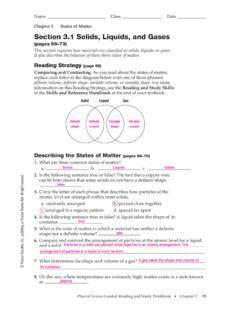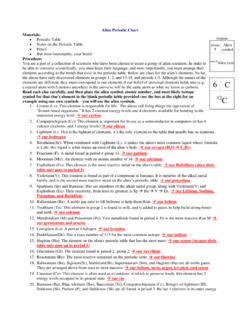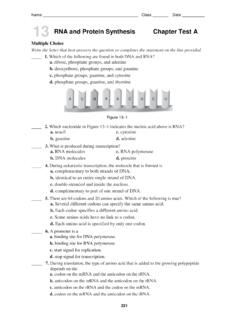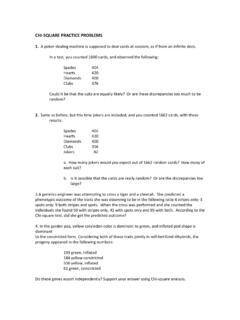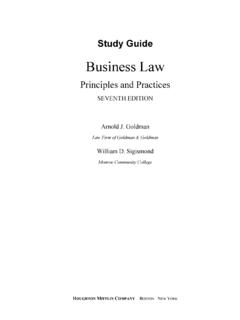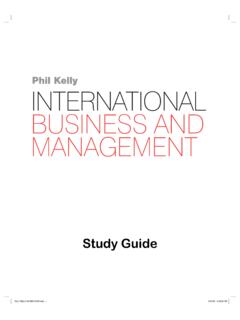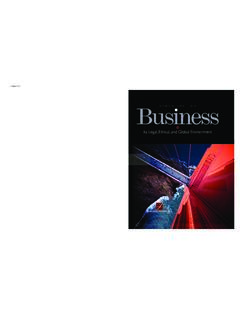Transcription of CHAPTER 3 Court Systems - bisd303.org
1 LAW for business and Personal Use 2012 cengage Learning. All Rights Reserved. May not be scanned, copied or duplicated, or posted to a publicly accessible website, in whole or in part. CHAPTER 3 Court Systems 3-1 Forms of Dispute Resolution 3-2 The Federal Court System 3-3 State Court Systems LAW for business and Personal Use 2012 cengage Learning. All Rights Reserved. May not be scanned, copied or duplicated, or posted to a publicly accessible website, in whole or in part. CHAPTER 3 SLIDE 2 3-1 Forms of Dispute Resolution GOALS Explain how disputes can be settled without going to Court Name the different levels of courts and describe their jurisdictions and powers LAW for business and Personal Use 2012 cengage Learning.
2 All Rights Reserved. May not be scanned, copied or duplicated, or posted to a publicly accessible website, in whole or in part. CHAPTER 3 SLIDE 3 DISPUTE RESOLUTION How can disputes be resolved without going to Court ? Negotiate parties meet face-to-face and try to settle a dispute Mediator independent third party brought in to help settle a dispute tries to develop a solution acceptable to both sides of the dispute gives suggestions for solution only Arbitrator holds informal hearing to determine facts legally binding on both parties can be enforced by courts if necessary LAW for business and Personal Use 2012 cengage Learning.
3 All Rights Reserved. May not be scanned, copied or duplicated, or posted to a publicly accessible website, in whole or in part. CHAPTER 3 SLIDE 4 How do courts settle disputes? Two levels Administer justice under the law Award damages or other appropriate relief Impose punishment fine imprisonment DISPUTE RESOLUTION LAW for business and Personal Use 2012 cengage Learning. All Rights Reserved. May not be scanned, copied or duplicated, or posted to a publicly accessible website, in whole or in part. CHAPTER 3 SLIDE 5 How do courts settle disputes? Trial courts After all mediation has been exhausted, trial Court is first to hear a dispute.
4 Called to testify parties/sides on facts and rule of law DISPUTE RESOLUTION LAW for business and Personal Use 2012 cengage Learning. All Rights Reserved. May not be scanned, copied or duplicated, or posted to a publicly accessible website, in whole or in part. CHAPTER 3 SLIDE 6 Trial courts, cont. Civil plaintiff brings charges Criminal government (state or federal) initiates case and serves as prosecutor Responding party in both civil and criminal is the defendant. DISPUTE RESOLUTION LAW for business and Personal Use 2012 cengage Learning.
5 All Rights Reserved. May not be scanned, copied or duplicated, or posted to a publicly accessible website, in whole or in part. CHAPTER 3 SLIDE 7 How do courts settle disputes? Trial courts, cont. steps in a trial Statement Plaintiff/Prosecutor Statement Defense Examination by Plaintiff/Prosecutor by Defense Examination by Defense by Plaintiff/Prosecutor Statement by Defense Argument Instructions : criminal = beyond a reasonable doubt civil = preponderance of the evidence, 51% of evidence must support plaintiffs claims DISPUTE RESOLUTION LAW for business and Personal Use 2012 cengage Learning.
6 All Rights Reserved. May not be scanned, copied or duplicated, or posted to a publicly accessible website, in whole or in part. CHAPTER 3 SLIDE 8 DISPUTE RESOLUTION How do courts settle disputes?, cont. Appellate courts The losing party of a trial presents arguments asking the Court to review the decision of the trial Court . The other party presents arguments supporting the trial courts decision. not always an available option no juries no witnesses no new evidence is presented only the lawyers and judges LAW for business and Personal Use 2012 cengage Learning.
7 All Rights Reserved. May not be scanned, copied or duplicated, or posted to a publicly accessible website, in whole or in part. CHAPTER 3 SLIDE 9 DISPUTE RESOLUTION How do courts settle disputes?, cont. Appellate courts, cont. Error of Law Occurs when the judge makes a mistake as to the applicable law wrong instructions permitted evidence that should not have been allowed In cases involving minor errors of law the trial Court decision will not be reversed LAW for business and Personal Use 2012 cengage Learning. All Rights Reserved. May not be scanned, copied or duplicated, or posted to a publicly accessible website, in whole or in part.
8 CHAPTER 3 SLIDE 10 DISPUTE RESOLUTION How do courts settle disputes?, cont. Appellate courts, cont. Error of Law Occurs when the judge makes a mistake as to the applicable law wrong instructions permitted evidence that should not have been allowed In cases involving minor errors of law the trial Court decision will not be reversed LAW for business and Personal Use 2012 cengage Learning. All Rights Reserved. May not be scanned, copied or duplicated, or posted to a publicly accessible website, in whole or in part. CHAPTER 3 SLIDE 11 CHECKPOINT What are the two levels of courts, and what is the function of each?
9 Courts Court of original jurisdiction Courts Court of review, concerned with issues of law LAW for business and Personal Use 2012 cengage Learning. All Rights Reserved. May not be scanned, copied or duplicated, or posted to a publicly accessible website, in whole or in part. CHAPTER 3 SLIDE 12 3-2 The Federal Court System GOALS Identify the source of power of the federal courts Name the major federal courts and describe their jurisdictions and powers LAW for business and Personal Use 2012 cengage Learning. All Rights Reserved. May not be scanned, copied or duplicated, or posted to a publicly accessible website, in whole or in part.
10 CHAPTER 3 SLIDE 13 ORIGIN OF THE FEDERAL Court SYSTEM Judiciary Acts established: Supreme Court 13 district courts Federal Courts of Appeal Specialized courts LAW for business and Personal Use 2012 cengage Learning. All Rights Reserved. May not be scanned, copied or duplicated, or posted to a publicly accessible website, in whole or in part. CHAPTER 3 SLIDE 14 ORIGIN OF THE FEDERAL Court SYSTEM Federal Courts: 94 federal judicial districts, all have a trial Court & bankruptcy Court 12 regional circuits, each has a Court of appeals 13 Federal Courts of Appeal located in Washington hears cases from the Court of International Trade, Court of Federal Claims, Court of Patent and Trademark Office, Tax Court , and Court of Veterans Appeals LAW for business and Personal Use 2012 cengage Learning.
